One in every 68 children is on the autism spectrum.
The San Rafael warehouse was full to the brim with classic cars; some of the men ogled the polished beauties, subtly brushing up against them, though no one dared take photos. Wine and appetizers made the rounds, and the crowd mixed it up before heading to tables to dine on everything from barbecue to Italian. The diners seemed content and a little quiet.
This is just where Willie Brown wanted them.
The former mayor of San Francisco was center stage at the front of the room and, after tossing off a few remarks and some gentle digs at the gentile Marin crowd, Brown got down to business as only he can. After spending much of his life being elected and telling voters what they wanted to hear while cutting all manner of political deals, Brown sized the crowd up and, in a teasing voice, told them to get their checkbooks out.
The former politician was fronting an unusual fund-raiser for something of an unusual cause. Anova, the Santa Rosa-based education nonprofit, was raising money for a new campus in Marin. And Brown had volunteered to emcee the evening, which included him shaking down the crowd.
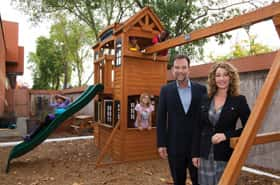 Founded in 2000 by Mary Beth Ludwig and Andrew Bailey, Anova has a trio of schools (located in Marin, Sonoma and Contra Costa counties) serving 200 students from 12 counties. The schools provide educational, behavioral and therapy services for students age 5 to 22 with high functioning autism, Asperger’s Syndrome, social and emotional challenges, learning differences and other neuro-developmental impairments.
Founded in 2000 by Mary Beth Ludwig and Andrew Bailey, Anova has a trio of schools (located in Marin, Sonoma and Contra Costa counties) serving 200 students from 12 counties. The schools provide educational, behavioral and therapy services for students age 5 to 22 with high functioning autism, Asperger’s Syndrome, social and emotional challenges, learning differences and other neuro-developmental impairments.The Marin Anova School is located on the campus of Davidson Middle School in San Rafael. Opened in 2008, it’s not only limited by its shared location, but it also lacks basic elements. “We aren’t looking to build a campus that is by any means over the top,” says Bailey, Anova’s CEO. “We need a home. We don’t have a library, gym or cafeteria. There’s no play area.”
Bailey, a personable guy who has a tendency to speak when others might tire, chafes at the idea that some might view Anova as a private school catering to well-off families. “The truth is that we’re a quasi-public entity. Our funding comes from the public because our students come from public schools, and the districts pay for the services. But unlike public schools, we can’t float bonds to pay for a new school. And since we are a nonprofit, if something were to happen to Anova, the facilities would go to the community.”
While talking about the hunt for a new location for the Marin Anova campus, Bailey makes a confession: “My house had a second mortgage so we could make payroll while our students were getting public funding to attend Anova. The Anova School program has run in the red ever since we opened. There is no waste. Our overhead is 13 percent, which is very low for a nonprofit.”
Under state educational code, students in California are entitled to a free and appropriate public education under the least restrictive environment. This law can pose a problem for public school districts, which have limited resources, when students have specific educational or physical challenges that aren’t easily addressed.
Public school students who have learning disabilities or physical or emotional challenges are evaluated by district personel and an individual education plan (IEP) is created to meet the student’s needs and goals. The goals of that plan are revisited each year and a new IEP is created every three years.
This is where Anova comes in. For some students in some districts, Anova’s approach is a good fit. In those cases, the school district pays for the student to attend Anova.
A recent study by Harvard University shows that the cost of special education and medical services for a child on the autism spectrum is $17,000 per year. Data from the National Center for Educational Statistics shows schools on a national basis spend an average of $12,600 annually on each student. In California, the capital of high technology and home to the world’s eighth largest economy, the spending is just $8,482 per student, ranking the state 49th nationally.
The gap between what’s funded and what’s needed isn’t small—and Bailey says things are going to get worse. “The primary problem is, there are too many kids on the spectrum who need help, and the public schools need help as well.”
Bailey says autism is going to become a much more complex problem. “We’re heading into uncharted territory. In the next 10 or 15 years, we’re going to have homes filled with adults who are on the spectrum and need help. We, as a society, have tough decisions ahead. And because of how we deal with things, we’ll likely wait until there’s a crisis.”
In the spirit of full disclosure, my wife works for San Rafael City Schools as a special education administrator, so I’m slightly more enlightened on how some students require something beyond the everyday curriculum.
Even more disclosure: I have a nephew in Montana who is on the autism spectrum.
The project
While Willie Brown was putting the bite on the crowd, I looked around the room. As a member of media, I was used to being in places where I hung on the periphery and wasn’t the target demographic. It wasn’t that the car warehouse was filled with swells and trust fund kids who were going to write checks full of zeros, but as Brown slid his hard sell into silk, easing his rap into a delicious candy shell, I thought, ‘This audience doesn’t need too much seduction; they want to write the checks. These people are friends of the school, parents with Anova kids and other folks who’ve been touched by autism.”
They were believers.
As the formal parting of the money began, a gentleman rose in the audience and approached Brown, beckoning him to the side of the stage. They spoke quietly and then in a stage whisper, Brown said, “That is going to cost you, Sir.”
The former mayor said that the man had offered to match any donation that Brown made. Maybe the guy was trying to get the former mayor to put his money where his legendary mouth was. Maybe the whole thing had been cooked up before the guests had filed in to gaze upon Jags and T-Birds and drink up wines from former Indy driver A.J. Foyt. But Brown announced that he was coming out-of-pocket to the tune of $5,000.
So Brown kicked off the capital campaign. Bailey says Anova is in it for the long haul, with a projected five-year campaign hoping to raise a total of $10 million. So far, the coffers have $300,000, and the school is open to getting creative in its funding efforts. “We have naming opportunities, Bailey says, only half-joking. “So if George Lucas, or somebody else is interested, we’re open to new ideas.”
Anova is still searching for a location for the new school; a possibility fell through in 2014. While a spot on the former Hamilton Air Force Base has been talked about, Bailey says a more central location in San Rafael might make more sense. The nonprofit has factored in the notoriously slow planning process in Marin. “We figure it will take two or three years to put a design together and gain the approvals and another two years to build it out.”
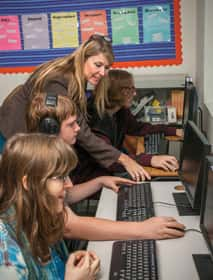 What the school does
What the school does
Like any forward-thinking nonprofit or for-profit business, Anova has created and promotes its brand. Its schools are known as Anova Center for Education or ACE. Students at ACE schools receive The Anova Method of Education. To an outsider, this simply seems like an effective way to differentiate the product while establishing the schools in a larger educational community. But upon closer inspection, Anova’s approach is different because it must be.
Its students have challenges that include learning disabilities, sensory processing deficits and pragmatic language delays. In some cases, the students are “twice exceptional”—both academically and cognitively gifted—but they have difficulty “taking the perspective” of others. So, besides teaching the standard academic subjects like language arts, math and history, Anova must gear its instruction to include social cognition therapy, sensory integration and occupational therapy.
While public schools educate kids to impart skills that can be honed in college so the student will be able to choose a career and be productive, Anova is in the position of having to teach skills that students and teachers in public schools take for granted—skills that will help its students relate to others and have successful interactions.
“It’s like if you’re going to Starbucks first thing in the morning. You know that wearing your pajamas wouldn’t be normal and you might comb your hair,” Bailey says. “If you were there and saw something strange, you might not say anything. It’s the ‘social fake,’ and most of us understand that. But for some of our students, it’s like watching the movie ‘Liar, Liar’ with Jim Carey, where they tell the truth no matter what. Sometimes that doesn’t go so well.”
So Anova uses talk therapy to work on a “social vocabulary” to help kids make and keep friends. “We do nothing that’s punitive. If someone does something that’s out of place or wrong, we say ‘That was unexpected.’ That leads to a brief discussion of what’s expected and what’s unexpected in any given social context. It helps our students to take the other person’s perspective, which is essential for relationships,” Bailey says.
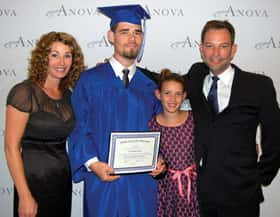 The end
The end
While the cars were gorgeous, the food delicious and the wine intoxicating, the best part of the evening was when a former Anova student took the stage. I’m not using his name because he works in the Bay Area in public safety and, while he does his job quite well, his employer may not know about all of his educational background.
He talked about his days at Anova, what the school had meant to him, how it had helped shape him as a person and given him an opportunity to go to college and beyond. It wasn’t so much his words, though they were fine. It was the way he looked at those sitting at the tables, those who had a chance to help build a new school and help others get his chance. There are those who light up a room with their smiles.
All he had to do was stand there.
Autism Myths and Realities
In recent years, autism has gone from being a disorder that no one wanted to talk about to being portrayed on a TV series (“Parenthood”) and being featured by the Giants as a fund-raiser at AT&T Park. While it isn’t trending on Twitter, it’s at least on the national cultural radar. Still, there are lots of myths about autism.
Myth: Autism is a recent phenomenon.
Reality: Autism was identified by Dr. Leo Kranner in 1943.
Myth: Autism is caused by childhood vaccines.
Reality: This theory first popped up in the late 1990s. Though that study has been rebuked, debate on the Internet rages on, led by noted medical authority and Playboy model Jenny McCarthy.
Myth: Bad parenting causes autism.
Reality: Though the cause(s) of autism have not been firmly determined, researchers now suspect that genetic susceptibility, combined with unknown environmental insults, are the most likely cause for most cases of the neurological disorder.
Sources: Anova, the U.S. Center for Disease Control and the Autism Society
Autism by the Numbers
• One in every 68 children is on the autism spectrum. That number is up from one in 150 in 2000.
• Autism is the fastest growing developmental disability in the United States and exceeds those with juvenile diabetes, childhood cancer and pediatric AIDS combined.
• About 1 percent of the world’s population is on the autism spectrum. In the United States, autism affects 15 million people on a daily basis.
• The total lifetime costs for caring for a person with autism is $3.2 million.
• The costs of autism annually in the United States are someplace between $236 billion and $262 billion. About $175 billion to $191 billion of those costs go for providing services for adults in the spectrum, and the costs in 10 years may grow to $400 billion per year.
• The costs for treating autism can be reduced by two-thirds with early diagnosis and intervention.
• About 35 percent of young adults (ages 19 to 23) with autism have not had a job or received postgraduate education after leaving high school.
• Each year, 50,000 kids with autism transition into adults without adequate vocational planning. People with autism have the same life expectancy as those without it.
Sources: Anova, the U.S. Center for Disease Control and the Autism Society
Autism Speaks: Advocacy or Controversy?
By Bill Meagher
Autism Speaks is the most well-known autism advocacy group in the United States. The New York-based nonprofit organization was founded in 2005 by the former vice chairman and executive officer of General Electric, Bob Wright, and his wife, Suzanne, after they became frustrated trying to find services for their grandson, Christian.
The organization has raised the profile of autism while raising millions for research and lobbying Washington to leverage those funds. It’s literally put autism on the map. And now some in the autism community are asking whether it’s heading in the right direction.
While the organization has raised many millions for research and reformed insurance practices in 38 states (plus the District of Columbia and U.S. Virgin Islands) so that carriers cover at least a portion of expenses that families dealing with autism face, Autism Speaks has also come in for criticism for its overhead, positions on the role of vaccines in causing autism and its sometimes controversial public statements.
The breakdown of where funds that are raised by nonprofits are spent has become a battleground for many organizations. Tax records from 2012 show salaries for Autism Speaks’ top two executives totaled more than $1 million.
More than a dozen scientific studies have dispelled the idea that vaccinations cause autism, but others have shown there may be a connection. Autism Speaks continues to fund research into the link between autism and vaccinations. Critics say that money could be used in ways that would better aid the autism community.
The vaccine controversy cost the organization its first chief executive, Alison Singer, in 2009. When Singer, the mother of a daughter with autism, walked, she said, “When you start talking about what you believe and not what data shows, you’re talking about religion and not science.”
Last year, Suzanne Wright made a very public pronouncement that those with autism were viewed by legislators in Washington, D.C., as “not living.” In part, she also said, “Close your eyes and think about an America where 3 million Americans and counting largely cannot take care of themselves without help. Imagine 3 million of our own unable to dress, or eat independently, unable to use the toilet, unable to cross the street, unable to judge danger or the temperature, unable to pick up the phone and call for help.”
Wright’s statement caused author John Elder Robison to leave the organization’s board. Robison, the author of a book on autism, Look Me in the Eye, was the only member of the board with autism.
Life with Purpose
By Alexandra Russell
“It’s often said that people with autism don’t do much socializing, but we believe there’s opportunity for coming together.” —Deirdre Sheerin
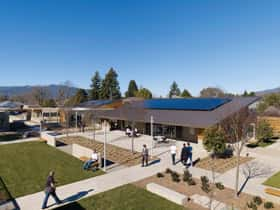
Sweetwater Spectrum in Sonoma is a unique residential community designed for adults with autism. Made up of a quartet of four-bedroom homes and a community center set on three acres in a quiet residential neighborhood, it’s an unexpected oasis for a vastly underserved population.
“It was founded by families who came together and decided they wanted something different than what was traditionally offered, such as group homes,” explains Deirdre Sheerin, CEO/executive director of Sweetwater. “Working with civic leaders and autism professionals, they went around the country exploring other models and housing options. They conducted focus groups with other people who had children with autism, as far as what their ideas, ambitions and hopes were for their sons and daughters. They knew they wanted someplace where residents could age in place, because one of the greatest worries for families of people with autism is, ‘What happens when we’re not here anymore?’”
Creating a community
Sweetwater was “designed to consider the sensitivities and challenges faced by people with autism,” says Sheerin, including discomfort with many interpersonal interactions, unease at the prospect of unexpected change and hypersensitivity to loud noises, overly bright lights and other jarring sensations. Design elements include wide walkways and lines of sight, so residents can see what’s ahead and make predictions and choices before being faced with a situation. Outdoors, structural headways gently signal transitions between spaces. And all four houses and the community center feature muted colors and share a basic blueprint, so even moving from one structure to another holds a familiar feel.
A large community garden and chicken coop offer outdoor work opportunities (a full-time gardener grows microgreens and fresh vegetables onsite, which the Sweetwater community sells at its seasonal farmstand and delivers fresh to local restaurants). An inground pool was the only feature 100 percent of founding families insisted on, because, says Sheerin, “Water seems to be especially comforting to people with autism.”
The community center serves as a gathering place for residents and their aides to socialize, exercise and create. One room holds treadmills and other exercise equipment, an art center is available around the clock, and a community enrichment director plans gatherings like potluck dinners, movie nights and holiday celebrations. “It’s often said that people with autism don’t do much socializing, but we believe there’s opportunity for coming together and being part of a whole community,” says Sheerin. “But it’s not required. Residents participate at their own comfort level.”
It’s this type of choice that makes Sweetwater so different. “Our residents choose who they want to live with,” explains Sheerin, who has a background in special education and organizational development. “We’re also an open-but-gated community, so our residents can come and go as they wish.” By encouraging independence and community engagement, she says, residents are “thriving and really defining who they are as individuals.”
Establishing support systems
Sweetwater Spectrum doesn’t provide any direct support or care to residents. Rather, Sheerin explains, “We’re a public/private partnership: We’re private housing, but we also work with the public system. In that public system, everyone with a disability gets an assignment of support depending on his or her needs. We rent to anyone on the autism spectrum, so we have some people who need 24/7 support and others who need less.”
Support staff are employed by vendors who are contracted through the North Bay Regional Center (which is a representative for the California Department of Developmental Services), but because of the nature of the work, the relationship is anything but professionally distant. “They’re part of our family,” says Sheerin, who’s working with other autism-focused organizations to help develop guidelines and tools for working with autistic adults. Calling it “a fast-growing field,” she hopes to help standardize training and establish it as a separate professional field.
Sweetwater operates under a Supported Living Services Model, laid out by California code through the Lanterman Act. “It’s being able to support a person in his or her own home,” says Sheerin. “It’s providing the services and the structure necessary to be able to live as independently as possible in the community of their choice. All residents receive SSI, and that’s what they pay the rent with. We also have a ‘community fee,’ which is either paid through donations or by the family.” Residents currently range from 19 to 35 years old.
Making a model
According to Sheerin, almost all new developments in autism-related fields—schools, housing, employment—are being driven by families. Sweetwater Spectrum and the Anova Method of Education are two local examples, and both, it seems, have the potential to change the landscape nationally.
Says Sheerin, “We’ve been given a grant to solidify the practices it took to build this place and to do some evaluating: Did we do the right things? Were our processes efficient?
“It’s a four-phase grant, and we’ve been funded for the first phase. The second phase is marketing: How do we communicate to other groups what we’ve done? The founders, from the very beginning, wanted to create a model that could be replicated nationwide.”
Sheerin is quick to clarify that, “It’s about the culture we’re creating. People can get overwhelmed by these beautiful buildings and think they couldn’t possibly replicate it, but this kind of community could be created with adjacent houses. It really is about creating choices in housing. We can teach people about the complexities of creating housing for adults with autism even if they’re not going to do this big of a project. There’s momentum: People are looking for alternatives right now.”
Ultimately, she’s not just referring to residential alternatives: “Not only do adults with autism need housing choices, they really need meaningful volunteer activities and day programs,” she says. “That’s what we all want. We’re helping them find a life with purpose.”
Author
-
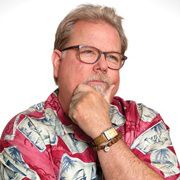
Bill Meagher is a contributing editor at NorthBay biz magazine. He is also a senior editor for The Deal, a Manhattan-based digital financial news outlet where he covers alternative investment, micro and smallcap equity finance, and the intersection of cannabis and institutional investment. He also does investigative reporting. He can be reached with news tips and legal threats at bmeagher@northbaybiz.com.
View all posts



